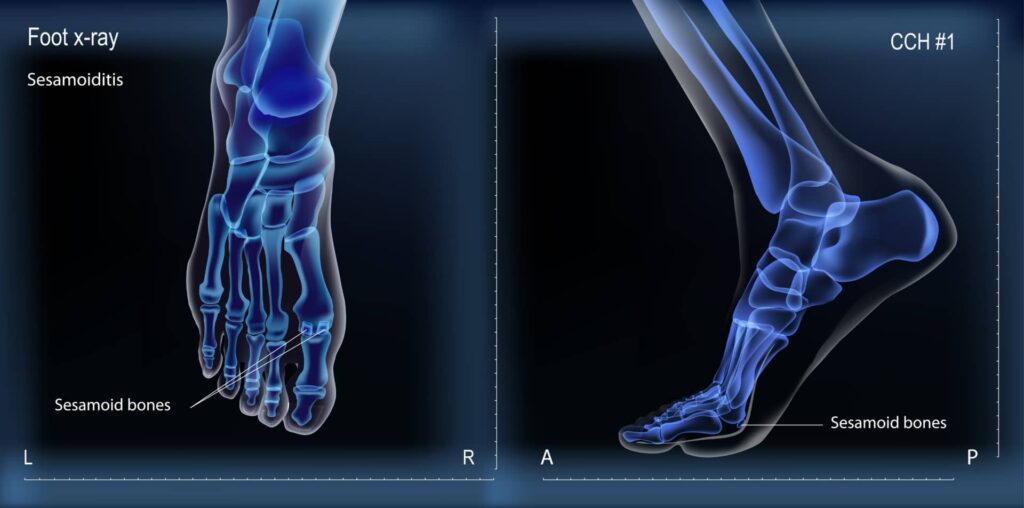Nearly every bone in the human body is connected to other bones via joints — be it a shoulder, elbow, hip, knee, ankle, or other smaller joint. However, there are a few bones in the body called sesamoids that do not connect to joints and are only connected to tendons or embedded in muscles. The largest of these bones is the patella (kneecap); two of the smallest can be found in the foot.
These sesamoids are two small bones embedded in tendons on the ball of the foot beneath the big toe joint. These bones provide leverage for these tendons to create normal movement of the big toes when walking or running. They also help bear weight and absorb pressure on the forefoot with each step. Sesamoiditis is inflammation of the sesamoids and the surrounding tendons due to overuse or increased strain over time. Activities requiring repetitive pressure on the ball of the foot, such as running, dancing, or wearing uncomfortable shoes, can cause sesamoiditis.
What does sesamoiditis feel like?
The symptoms of sesamoiditis typically arise when the soft tissue around the sesamoids gets repeatedly overworked. The main identifying characteristic of sesamoiditis is the gradual onset of dull pain under the big toe joint that worsens over time. Swelling, redness, bruising, and difficulty walking may also occur as the pain intensifies. Eventually, bending the big toe and bearing weight can become both difficult and very uncomfortable. A popping sensation while walking is also common.
What causes sesamoiditis and who’s at risk?
The leading cause of sesamoiditis is repetitive pressure and stress on the sesamoids. Runners, dancers, and other athletes frequently develop sesamoiditis, but it can also result from factors like:
- High foot arches or flat feet
- Poorly fitting shoes that cramp the toes (particularly high heels)
- Excessive inward foot rolling while walking (overpronation)
- Occupations requiring extensive time on your feet
- Gout
Diagnosis & Sesamoiditis Treatment
Your podiatrist will perform a foot exam to check for localized tenderness and pain when moving the big toe joint. Your doctor may manipulate the joint to reproduce symptoms to get a full understanding of what is causing your pain. Depending on the physical exam, they may order imaging to evaluate your foot for bone issues or soft tissue injury. X-rays can detect any fracture, while CT, MRI, or ultrasound will provide a better visualization of inflammation and tendon damage around the sesamoids.
Various sesamoiditis treatment at home is the mainstay for managing sesamoiditis:
- Anti-inflammatories and icing to alleviate pain and swelling
- Rest and activity modification to reduce strain on the sesamoids
- Sesamoiditis taping can help provide temporary pain relief by limiting movement and reducing pressure on the bones
- Orthotic inserts and sesamoiditis padding can provide extra cushioning
- Sesamoiditis exercises and physical therapy can help restore strength and range of motion
- Soft tissue therapy (ultrasound and massage)
- Steroid injections for pain may be used for severe cases
In rare chronic cases, sesamoiditis surgery to remove one or both of the sesamoid bones may be recommended.
Recovery Timeline, Preventing Reinjury & FAQs
The sesamoids play an integral role in normal foot biomechanics and protecting these little bones from excessive overload keeps them working smoothly. Paying attention to persistent sesamoid pain and pursuing prompt treatment aid recovery and prevent chronic problems down the road.
Recovery from sesamoiditis is gradual as pressure on the sesamoids must be minimized over time and it’s important to only resume normal activities if cleared by your doctor to avoid reinjury and prevent chronic issues. Preventative care through appropriate footwear and training modifications is key.
Because anyone can develop sesamoiditis, being aware of risk factors can aid in prevention:
- Wear properly fitted, cushioned shoes with plenty of toe room
- Consider custom orthotics for sport-specific impact absorption
- Limit repetitive forefoot impact through training adjustments
- Rest, ice, and elevate feet following intense activity
- Seek early intervention at the first sign of pain
Sesamoiditis FAQs
Is it okay to walk with sesamoiditis?
Initially, walking should be limited depending on severity. Some patients require a walking boot or cast to immobilize the joint until swelling and discomfort are better controlled. Weightbearing too early in the recovery process risks worsening tissue inflammation and damage. With treatment, light activity can gradually resume as pain permits.
What aggravates sesamoiditis?
Activities straining the forefoot — especially high-impact exercise directly over the sesamoids — tend to worsen pain and prolong healing. Poorly fitting shoes can also exacerbate symptoms. Likewise, allowing mild cases to progress to chronic injury results in increased pain levels and a longer recovery.
Can sesamoiditis heal on its own?
Mild cases generally resolve within days with at-hoe treatment and rest. More significant injuries can take weeks or months depending on severity. Surgery may sometimes be required for chronic sesamoiditis unresponsive to conservative treatments.
If you’re experiencing foot pain that may be sesamoiditis, it’s important to seek treatment from your local podiatrist or foot and ankle specialist. If you have questions about your condition, please contact us today.

